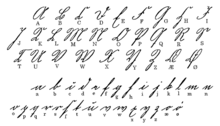Kurrent



Kurrent (German: [kʊˈʁɛnt]) is an old form of German-language handwriting based on late medieval cursive writing, also known as Kurrentschrift ("cursive script"), deutsche Schrift ("German script"), and German cursive. Over the history of its use into the first part of the 20th century, many individual letters acquired variant forms.
German writers used both cursive styles, Kurrent and Latin cursive, in parallel: Location, contents, and context of the text determined which script style to use.
Sütterlin is a modern script based on Kurrent that is characterized by simplified letters and vertical strokes. It was developed in 1911 and taught in all German schools as the primary script from 1915 until the beginning of January 1941. Then it was replaced with deutsche Normalschrift ("normal German handwriting"), which is sometimes referred to as "Latin writing".
Lettering examples
-
 Letter from Lessing to Kleist, 14 March 1758
Letter from Lessing to Kleist, 14 March 1758 -
 Manuscript by Wilhelm Busch (undated, late 19th century)
Manuscript by Wilhelm Busch (undated, late 19th century) - Example from a book published in 1905
-
 Kurrent script used for text in a 1916 children's book
Kurrent script used for text in a 1916 children's book -
 Signage on a municipal children's home (Städtisches Kinderheim) in Esslingen am Neckar in 2006
Signage on a municipal children's home (Städtisches Kinderheim) in Esslingen am Neckar in 2006 -
 A handwritten restaurant order in Kurrent from the 1920s
A handwritten restaurant order in Kurrent from the 1920s -
 Kurrent script from a 1903–14 primer on German, the 26 letters, ligatures, start of sample text
Kurrent script from a 1903–14 primer on German, the 26 letters, ligatures, start of sample text -
 Kurrent script from a 1903–14 primer on German, the rest of the sample text
Kurrent script from a 1903–14 primer on German, the rest of the sample text -
 Final paragraph of a German contract from 1750 signed by George II, King of Great Britain and Elector of Hanover. It contains a mixture of Kurrent and 'Latin font' scripts.
Final paragraph of a German contract from 1750 signed by George II, King of Great Britain and Elector of Hanover. It contains a mixture of Kurrent and 'Latin font' scripts. -
 Handwritten letter, 1792
Handwritten letter, 1792
See also
- Antiqua–Fraktur dispute
- Blackletter
- Fraktur (script)
References
External links

- German handwriting Schrift (in German) Overview and examples of Kurrent by N. A. Powell
- German language page about Kurrent, with history of German cursive handwriting and Kurrent
- Another version, by Lars Erik Bryld, called Manu Gothica
- Yet another version, by Peter Wiegel
- Kurrent-Schreibmaschine – Old German typewriter An online assistant for better reading Kurrent
In German Wikipedia
- Eszett (letter ß)
- Sütterlin handwriting
- Grundschrift handwriting
- v
- t
- e
and medieval
- Roman
- Rustic
- Uncial
- Visigothic
- Merovingian
- Carolingian
- Insular script
- Beneventan
- Blackletter
- Rotunda
- Bastarda
- Georgian
- Greek
- Early Cyrillic
- Ustav
- Poluustav
- Bosančica
- Glagolitic
- Court hand
- Lombardic






















